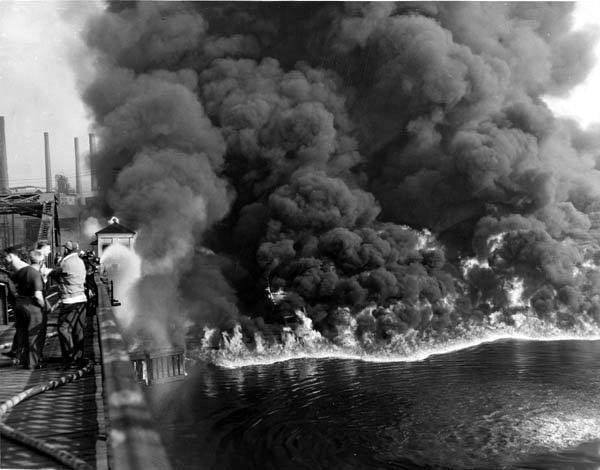What the Clean Water Act Means To Me
In 1972, Congress passed the Clean Water Act by a two-thirds majority and with strong bipartisan support, and a Republican president signed it into law.

This page was published 13 years ago. Find the latest on Earthjustice’s work.
Growing up just outside of Cleveland, Ohio, my siblings and cousins and I spent our summers swimming in Lake Erie. The water looked clear enough, and though I remember hearing about the invasion of zebra mussels, our greatest worries were the imagined creatures in the deep. We didn’t know that just a few years before, the lake was popularly deemed “dead” because of the pollution it received from surrounding industries.
And in 1969 — the same year that our Cuyahoga River caught fire because of pollution, the same year that 59 out of 62 total Lake Erie beaches were pronounced unsafe for swimming — Time magazine pointed the national spotlight to our set-upon lake:
Some lake! Industrial wastes from Detroit’s auto companies, Toledo’s steel mills and the paper plants of Erie, Pa., have helped turn Lake Erie into a gigantic cesspool.
It was that river fire and that lake in Ohio that set the country ablaze in a movement for pollution controls and a national law to protect our waters. In 1972, Congress passed the Clean Water Act by a two-thirds majority and with strong bipartisan support, and a Republican president signed it into law. And the act began its work in cleaning up our Cuyahoga and our beloved Lake Erie, so that in the decades following, people like me could swim and splash in it without harm to our health.
Growing up as a Cleveland girl, leaving home and telling folks where I was from was always humbling. “Oh yeah, ha! Didn’t your river catch fire?” and “The city whose river caught fire!” and “Even your lake was dead!” and “How does a lake die?” they’d say, incredulously.
That’s why, today, as we celebrate the 40th anniversary of the Clean Water Act, I am keenly aware of what this law has accomplished…and the challenges it still faces.
With respect to Lake Erie, though we’ve come a long way in cleaning it up, today we’re facing many of the same problems, some of which are threatening to return us to the lampooned and shameful days of our past.
Toxic green slime, or algae, is spreading through the lake with disturbing intensity, just as it did decades ago. Beaches are closing due to unsafe bacteria levels from sewage dumping in the lake, and fish and life that keep the lake healthy are dying. As a triathlete who swims in Lake Erie and other Great Lakes, this matters to me. And as a Clevelander at heart who cares about the economic stability of my hometown and the health of my family, it matters even more.
These clean water problems are not – and never have been – isolated to Ohio. Here in Washington, DC, where I live now, a host of similar problems plague this city’s past, present and future. More than 3 billion gallons of raw sewage are dumped each year into the Anacostia and Potomac rivers here in DC. The Potomac River was named the nation’s most endangered river this year, and I have chosen to skip swimming in this body of water.
Just a stone’s throw away from the polluted Potomac and Anacostia sit the hallowed halls of Congress, where many members and representatives are working to further weaken and gut the landmark Clean Water Act. Instead of working to uphold, enforce, and strengthen it to protect communities like Cleveland and Washington, DC, many politicians are attempting to write away our protections and flush away the Clean Water Act. They are not the first. These anti-clean water and pro-polluter efforts have been underway for a decade, and in that time we’ve watched many of our streams, lakes, rivers and wetlands lose the Clean Water Act protections that kept them clean for decades.
So, to echo the ridicule from my youth, how does a lake die? Well, it could die when pollution goes unchecked, and the nation’s leaders spend a decade dismantling the great Clean Water Act with a mess of loopholes, exemptions and weakening policies that favor industrial polluters over communities and public health. And that is exactly why we’re seeing these dirty-water problems making a comeback today.
If we don’t strengthen and defend our Clean Water Act as a nation, then we could find ourselves right back where we started: with burning rivers, dead lakes, unswimmable, unfishable beaches and creeks, undrinkable water, sickly communities and greater economic hardship.
After 40 years of the Clean Water Act, we should celebrate the strength of this great law. But we should also should be clear: Our waters aren’t safe and clean just because. If they are swimmable, fishable, and drinkable, it is because of dogged defense of the Clean Water Act. And on this anniversary, let’s resolve to work harder to promote clean water protections for all waters of the United States.
Established in 1989, Earthjustice's Policy & Legislation team works with champions in Congress to craft legislation that supports and extends our legal gains.
Earthjustice’s Washington, D.C., office works at the federal level to prevent air and water pollution, combat climate change, and protect natural areas. We also work with communities in the Mid-Atlantic region and elsewhere to address severe local environmental health problems, including exposures to dangerous air contaminants in toxic hot spots, sewage backups and overflows, chemical disasters, and contamination of drinking water. The D.C. office has been in operation since 1978.